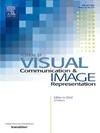一种基于多分类像素值排序的高保真可逆数据隐藏方案
IF 3.1
4区 计算机科学
Q2 COMPUTER SCIENCE, INFORMATION SYSTEMS
Journal of Visual Communication and Image Representation
Pub Date : 2025-05-10
DOI:10.1016/j.jvcir.2025.104473
引用次数: 0
摘要
像素值排序(PVO)是一种非常有效的技术,它采用像素块分区和排序来实现可逆数据隐藏(RDH)。然而,它的嵌入性能受到块大小的显著影响。为了解决这个问题,采用逐像素方法和自适应上下文大小,开发了一种改进的基于像素的PVO (IPPVO)。然而,IPPVO只考虑下方和右侧的像素进行预测,而忽略了其他更接近的相邻区域,导致预测不准确。本研究提出了一种使用多分类嵌入的RDH策略来提高性能。首先,基于奇偶坐标将像素分为四类,使用自适应最近邻内容大小获得更高的相关性预测值;其次,引入了一种新的复杂度计算方法,即像素区域的复杂度频率,以更好地区分复杂区域和平面区域;最后,引入有效的嵌入比和指标值约束,以缓解嵌入大容量时过度失真的挑战。实验结果表明,与目前最先进的基于pvo的RDH方法相比,该方法具有更好的嵌入容量和低失真。本文章由计算机程序翻译,如有差异,请以英文原文为准。
A novel high-fidelity reversible data hiding scheme based on multi-classification pixel value ordering
Pixel value ordering (PVO) is a highly effective technique that employs a pixel block partitioning and sorting for reversible data hiding (RDH). However, its embedding performance is significantly impacted by block size. To address this, an improved pixel-based PVO (IPPVO) was developed adopting a per-pixel approach and adaptive context size. Nevertheless, IPPVO only considers pixels below and to the right for prediction, neglecting other closer neighboring regions, leading to inaccurate predictions. This study presents a RDH strategy using multi-classification embedding to enhance performance. First, pixels are categorized into four classes based on parity coordinates, obtaining higher correlation prediction values using an adaptive nearest neighbor content size. Second, a new complexity calculation method is introduced, the complexity frequency of pixel regions to better differentiate between complex and flat regions. Finally, an effective embedding ratio and index value constraint are introduced to mitigate the challenge of excessive distortion when embedding large capacities. Experimental results indicate that the proposed scheme offers superior embedding capacity with low distortion compared to state-of-the-art PVO-based RDH methods.
求助全文
通过发布文献求助,成功后即可免费获取论文全文。
去求助
来源期刊

Journal of Visual Communication and Image Representation
工程技术-计算机:软件工程
CiteScore
5.40
自引率
11.50%
发文量
188
审稿时长
9.9 months
期刊介绍:
The Journal of Visual Communication and Image Representation publishes papers on state-of-the-art visual communication and image representation, with emphasis on novel technologies and theoretical work in this multidisciplinary area of pure and applied research. The field of visual communication and image representation is considered in its broadest sense and covers both digital and analog aspects as well as processing and communication in biological visual systems.
 求助内容:
求助内容: 应助结果提醒方式:
应助结果提醒方式:


